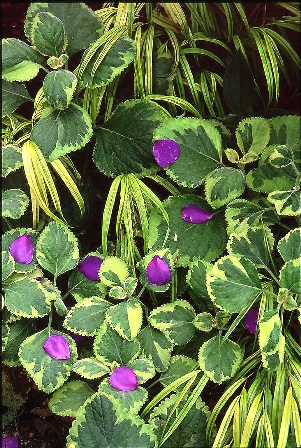I love this plant combination. It’s got shape, texture and color – especially color – working for it. I wish I thought of it, because this little vignette pushed my thinking about creating color combinations more than anything I’ve seen in a long time. Wesley Rouse created it, and here’s why I find it so ingenious: First there’s the elegant ground-covering combination of gold Japanese forest grass (Hakonechloa macra ‘Aureola’) and Plectranthus ‘Green on Green’, whose sharply contrasting shapes are united by their shimmering chartreuse and green hues. But then there’s that jolt of complementary color, those exquisite purple petals. Where did they come from? Well, they literally fell out of the sky. Planted in a pot and towering above the gold and green is a princess flower (Tibouchina urvilleana), a tender shrub with fuzzy, silvery leaves and exquisitely beautiful—and equally fragile- purple flowers. Any time it rains or gets windy, those beauteous blossoms shatter like glass and the petals rain down on the garden below. So Wesley planted that groundcover knowing it would provide a perfect color counterpoint for fallen princess flowers. I thought that pretty clever. By planning for fallen flowers to have, so to speak, a last moment in the sun, Wesley’s taking the inevitable process of decay and showcasing it, transforming it into a thing of transitory beauty.
I’ve since seen a similar scene, a late fall tableau, with bright red Japanese maple leaves creating an ankle-deep crimson carpet punctuated by the dark green foliage of hellebores rising through the fallen leaves. Wowsa!
Any other ideas?

